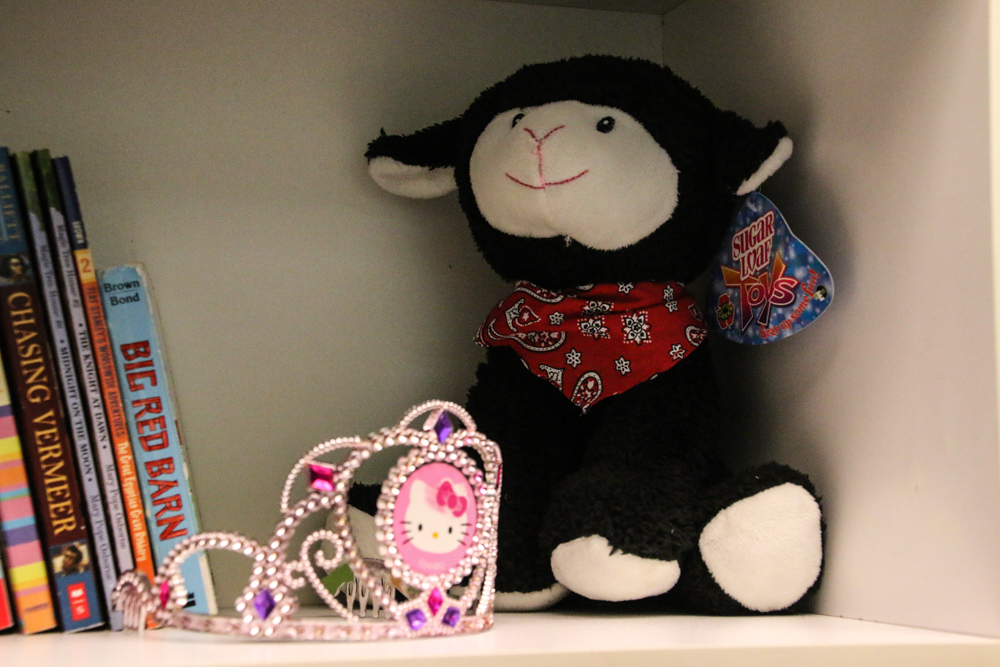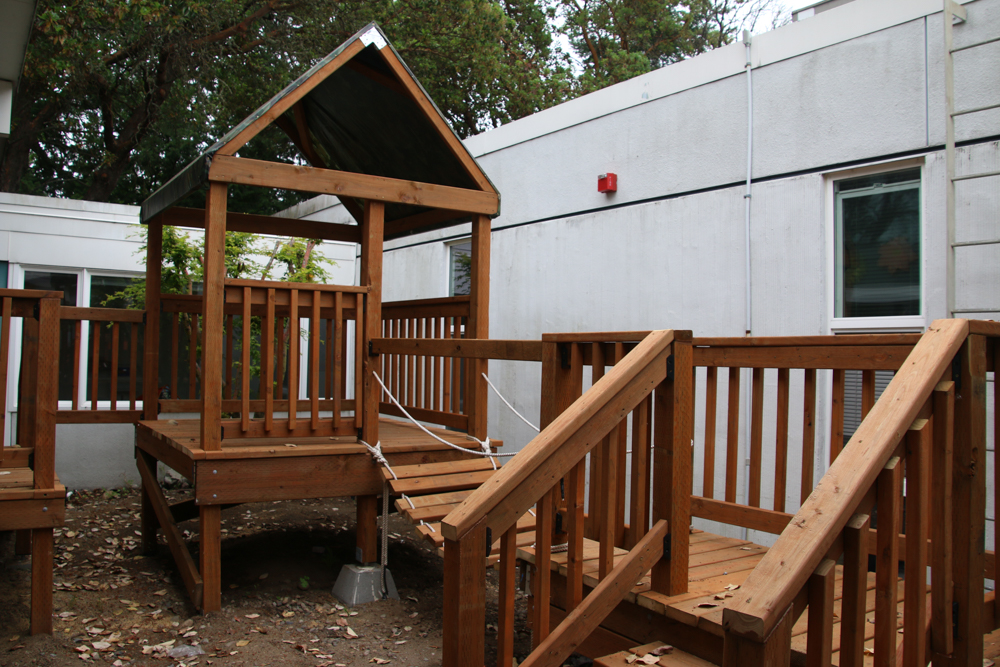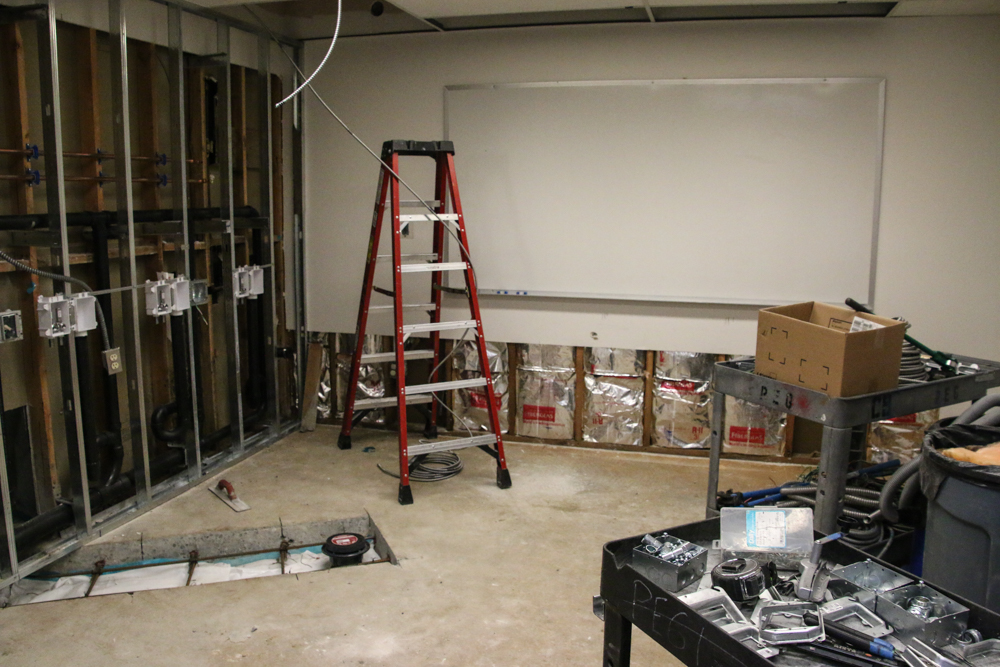(EDITOR’S NOTE: WSB and WCN are participating in the multiple-media-outlet #SeaHomeless day of special coverage. For the occasion, we revisited what is the White Center/West Seattle area’s only fulltime shelter, which opened in late March.)

(Toys on a shelf in the ‘mini-mart’ at the Mary’s Place shelter in White Center)
By Tracy Record
Editor, West Seattle Blog and White Center Now
It’s the shelter that almost wasn’t.
At an acrimonious community meeting last September – when King County revealed it was weeks away from opening a shelter at its former Public Health clinic in White Center – some threatened legal action to stop it.
But that’s not what happened.
Instead, community leaders and other residents formed a task force. They made a counter-proposal. Instead of the low-barrier, adults-only, overnight shelter that the county wanted the Salvation Army to operate, the counter-proposal was for a 24-hour family shelter to be operated by Mary’s Place, which specializes in helping homeless families.
The county agreed. Mary’s Place agreed. The followup community meeting in January had applause instead of shouting. And three months ago, the shelter opened at 8th SW/SW 108th. No lawsuits. No protests.
We toured on March 21st, just before the first families arrived. And that was the last time we visited the shelter – until this week, when we requested to drop in for a followup.
Our tour guide and interviewee was Liz McDaniel, family-shelter developer for Mary’s Place, who has been with the organization for eight years, dating back to when it was just the operator of a “day center” – now, it’s so much more. She understates her role: “I get to open all our new sites.” And in fact, she had opened a new one the night before our conversation, at the opposite end of King County, up in Shoreline.
But we were there to talk about White Center, the only fulltime shelter in the WC/West Seattle area. As of our Tuesday morning interview, 15 families were there, 55 people – 20 adults and 35 children. And there’s still room for more – official capacity is 70 people.
Another statistic: Since opening June 21st, the shelter “has served more than 3,400 bed nights.”
“Guests,” as Mary’s Place refers to the people it’s sheltering, are referred by the county program Coordinated Entry for All, which works with the 211 hotline.
And McDaniel says they are keeping “the promise that we made to the community, that we would prioritize families that are already in this neighborhood.”
Three months in, they are still completing renovations/additions that are needed so that the former clinic can truly serve as a livable space. One that catches our eye immediately upon entry fills a small atrium/courtyard:
The play area is the work of the Seattle University College of Engineering, we’re told. And like so many other things at the shelter, volunteers helped make it happen, including those who cleared the area of its weedy plantings.
Other work that is expected to be done by mid-July is adapting a restroom to make it accessible, and adding two showers in what was a storage area so the building has three – the Evergreen Aquatic Center, a mile away, has in the meantime been making its showers available to shelter families.
Crews also are converting another storage area into a laundry room:
In the meantime, all the laundry has to be sent offsite. And a “small kitchen” is being added as well, so some cooking can be done at the shelter.
So what happens during the course of a day at the shelter?
For the adults- “services that focus on housing and employment.” Throughout the open spaces in the shelter, there are signs, and set-aside areas, devoted to those focuses.
They get help working on applications, determining what are their barriers to housing, getting “tools to move forward.” The shelter has been open almost the exact length of an “average stay across all our locations” – 87 days. But three families already have moved out into housing, despite the challenge of rising rents, “harder and harder for families to afford, particularly if they’re a single-parent household – it’s challenging to find something to afford within Seattle. We spread the branches wide and look all over the place, White Center, Burien, Renton, Kent, places that families can afford.”
Mary’s Place also has launched a new “diversion program to help divert families from shelter directly into housing,” which requires “flexible funding,” so if you’re looking to donate money – that program could use it, she adds.
For employment, guests spend time filling out resumes, looking for openings, getting practice in “mock interviews.”
For the kids, there’s an immediate effort to be sure they are enrolled in school, and to arrange for transportation “within 48 hours of arriving.” This location is on school-bus routes, though at some of the other Mary’s Place sites in the region, they work with Metro, taxicabs, “whatever.” Now that school is out for the summer, the focus is on activities; McDaniel says they have been “working all year” on getting scholarships to day camps around the area, and kids are already out at camps ranging from art to environmental activities.
Health care also is available through the shelter, with a nurse on site part of the time.
Some aspects of shelter life involve clearing up misconceptions. McDaniel says some presume that shelters can be “a scary place – but we work hard to create a safe and welcoming community, where families can sit down and have a meal together, where kids can play appropriate to their age, where people feel welcomed as soon as they walk in the door … A lot of families are afraid they’ll lose their children when people find out they’re homeless. But your kids can’t be taken away simply (because of that).”
While Mary’s Place works on “a 90-day model … some families have more extended barriers” and it takes longer for them to get back onto their feet. Especially refugee families, McDaniel notes. Most of those who Mary’s Place is serving now are from East Africa, particularly Eritrea, though MP also has seen “our first few Syrian families,” as well as some from South Asia and Central America.
Wherever they are from, Mary’s Place emphasizes “the inherent belief that our families are good enough, and have the capability, to take care of their own families – they were housed at one point and they’ll be housed again. They have the tools to meet their own needs. There’s just a one-time gap – 97 percent of families experiencing homelessness will never experience it again. We help them navigate a really hard system at a traumatic time in their lives. We do it better together.”
Those working “together” at this shelter include about 20 staffers as well as the 55 guests, and volunteers. The guests have responsibilities beyond seeking housing and (if not already employed) work: They are assigned chores, for which points are awarded.
Those points can be spent at an on-site “store” with items such as clothing.
The youngest guests are able to earn points, too, and they have what the sign on the door dubs the “mini-mart” (top photo).
We asked McDaniel if the process of getting the shelter up to full speed has brought any surprises. “I think the biggest kind of joy and surprise has been the way the community has surrounded the space … we saw that in the work group and the process to get in. That has not waned. Between the schools and organizations already in the neighborhood” – she mentions White Center-headquartered WestSide Baby in particular – “(people) have stood alongside us and provided tools and resources to be sure this is a sustainable program in the community … White Center is such a strong community. People continued to bring in meals and donations and volunteer, and that excitement hasn’t gone away.”
A far cry from last September’s rancor.
WHAT YOU CAN DO: There’s a “daily need” for volunteers at the shelter – especially to help with the kids, “with outings, and during the school year with homework help,” McDaniel says. No prerequisites except to be “people who like people.” Information on volunteering is on the Mary’s Place website.
For donatable items – blankets and diapers remain their biggest need. (Yes, the kids at the shelter right now include babies.)
And the biggest need of all is space – this shelter is open, the aforementioned new one in Shoreline is open, but the need for more shelter space around the metro area continues. Despite that, this shelter is not intended to be permanent; the county and nonprofits are working on a long-range plan for a mixed-use project at the site that would include housing as well as headquarters for several nonprofits. That’ll be the topic of a separate followup.







| 7 COMMENTS